Recent Articles
Popular Makes
Body Types
2017 Alfa Romeo Giulia Road Test and Review
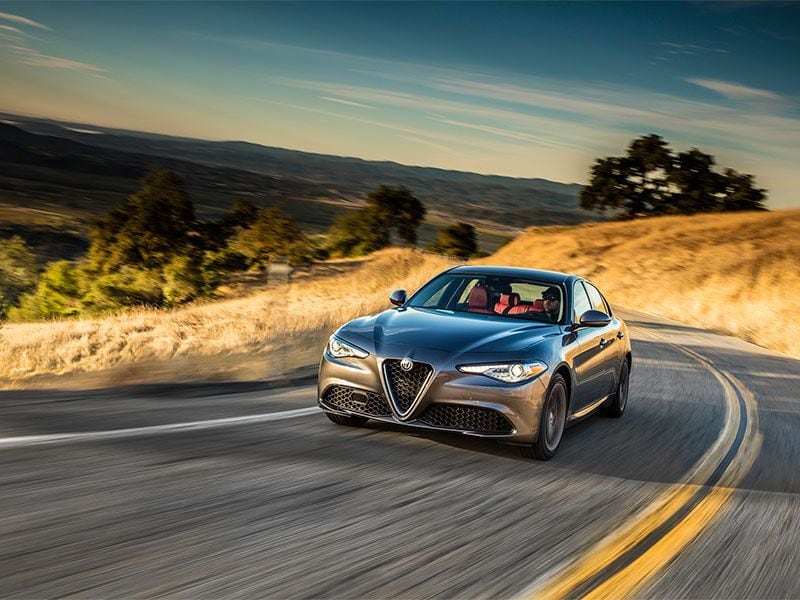
2017 Alfa Romeo Giulia front view on road ・ Photo by Fiat Chrysler Automobiles
Alfa Romeo: Depending on your age and experience, the name may mean nothing, or it may make you think of exotic and passionate cars. Or it may make you want to run away screaming. However you feel—or don’t—about Alfa Romeo, the brand is making its triumphant return to the US, and the Giulia is the first mass-market vehicle bound for American shores. So how does this new BMW competitor stack up? Let’s fire up the 2017 Alfa Romeo Giulia and take it for a spin.
Alfa makes its triumphant return
Alfa Romeo is an Italian car brand that first came to the States in the 1950s. Best known for its Spider roadsters, Alfa also sold a sport-luxury sedan called the 164, but poor sales led the Fiat-owned company to withdraw from the US market in the mid-1990s. Alfa has been gearing up for a return to the US for several years, having introduced the very-limited-production 8C sports car in 2008 and the lovely-but-completely-impractical 4C sportster in 2014. Fiat’s purchase of Chrysler has helped the company get a leg up in this country, and several Chrysler models (including the Dodge Dart and Jeep Cherokee) are already based on Alfa platforms. The model year 2017 sees the introduction of the first mass-market Alfa: The Giuila, a 4-door sedan aiming to compete with sporty luxury sedans like the BMW 3 series, Mercedes C-Class, Audi A4, and Cadillac ATS.
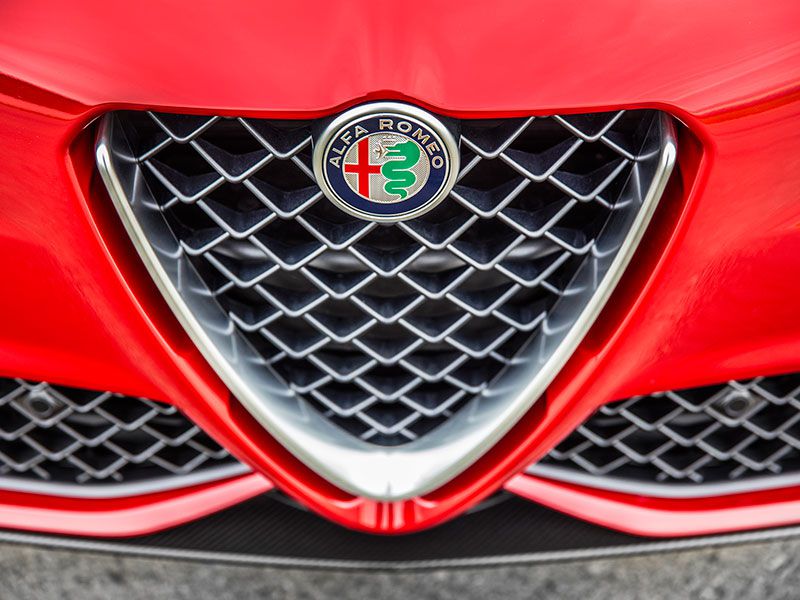
Photo by Fiat Chrysler Automobiles
How the Giulia sets itself apart...
So how does Alfa Romeo plan to distinguish the Giulia from this fantastic crop of cars? Look at the Giulia and the first part of the answer is obvious: Design, design, design. The Giulia is a beautiful car, a unique 5-seater highlighted by Alfa’s triangular grille. But there’s more here than a pretty face: The Giulia has lovely proportions that push the greenhouse (the glass area encompassing the people) toward the back of the car. The Giulia seems to sit back on its haunches, not lazily, but not aggressively either. Some cars look like they are ready to pounce; the Giulia looks like it will pounce if it must, but not before it has finished its glass of rosato and soaked up a little more of the Tuscan sun.
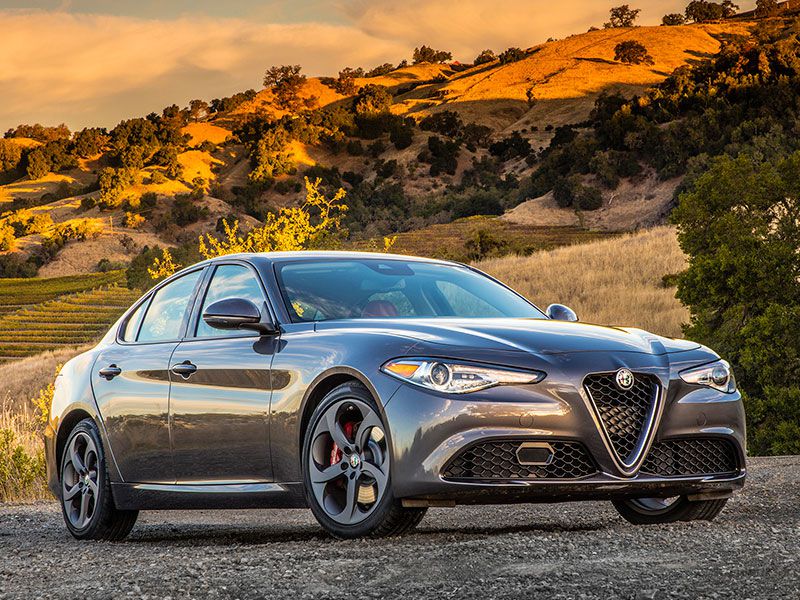
Photo by Alfa Romeo
Beautiful Outside and In
The Giulia’s beauty is more than skin deep: It is just as beautiful on the inside. Alfa’s stylists have designed a dashboard with gentle, sweeping curves and swathed it in high-quality leather (the standard upholstery choice, whereas many of the Giulia’s competitors come standard with vinyl). There are some 24 different color and trim combinations to complement the 12 exterior paint colors. As much as we love the design of the Guilia’s interior—note the way the infotainment screen is integrated into the dash, not tacked on like an afterthought—we love its simplicity: There are three dials for the climate controls and three more for the stereo and infotainment system placed on the center console, just behind the shifter. The Giula’s cabin seems to mock the complicated cockpits found in its German rivals, reminding them that there is more to life than maps with Google satellite imagery. As the industry rushes to turn its cars into mobile data centers, the Giulia reminds us that sometimes, to paraphrase Freud, a car is just a car.
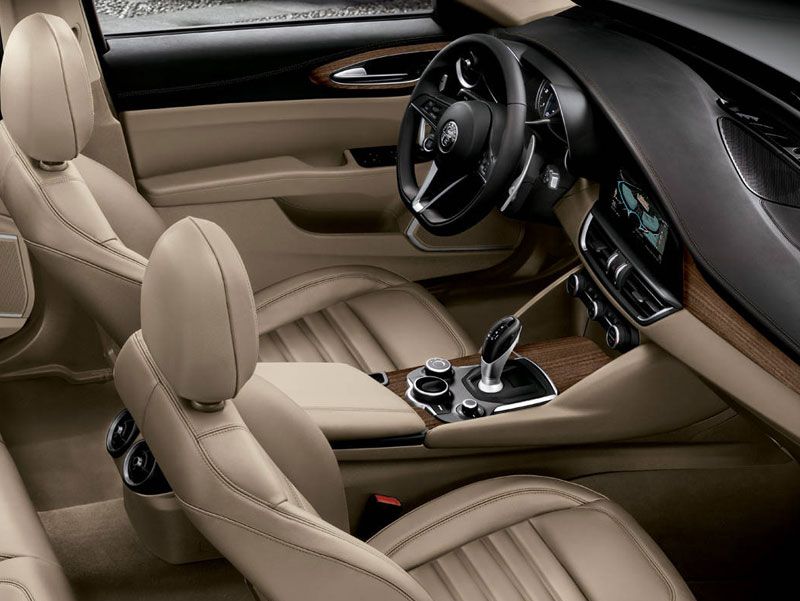
Photo by Fiat Chrysler Automobiles
Italian quirks
Of course, it wouldn’t be an Italian car if there weren’t a few ergonomic glitches. They are hard to find in the Giulia, but they are there. The best example is the big steering-column-mounted paddle shifters (not present in all Giulias) that block the wiper switch and turn signal stalk. We’re also a bit baffled by Alfa’s choice of stereo and navigation software: Chrysler’s UConnect system is one of the best in the business, and Fiat has fitted it to their other brands (including Maserati)—and yet the Giulia uses its own system, presumably one developed by or for Alfa. Although sound from the stereo is excellent, the system itself is nowhere near as intuitive to use as UConnect, nor are the graphics as good. We think Alfa is doing its buyers a disservice by fitting the second-best system to the Giulia. Other flaws: While the front seats are comfortable and positioned to offer excellent outward vision, the Giula’s back seat feels small, all the more so because little attention has been paid to providing toe-room under the front seats. The trunk is not particularly generous; Alfa has not released an official volume figure, but it looks to us to be around 12 or 13 cubic feet, which isn’t very big. Of course, one can forgive both of these flaws if one remembers Raul Julia’s First-a Rule of Italian Driving from 1976’s The Gumball Rally: “What’s-a behind me is not important.”
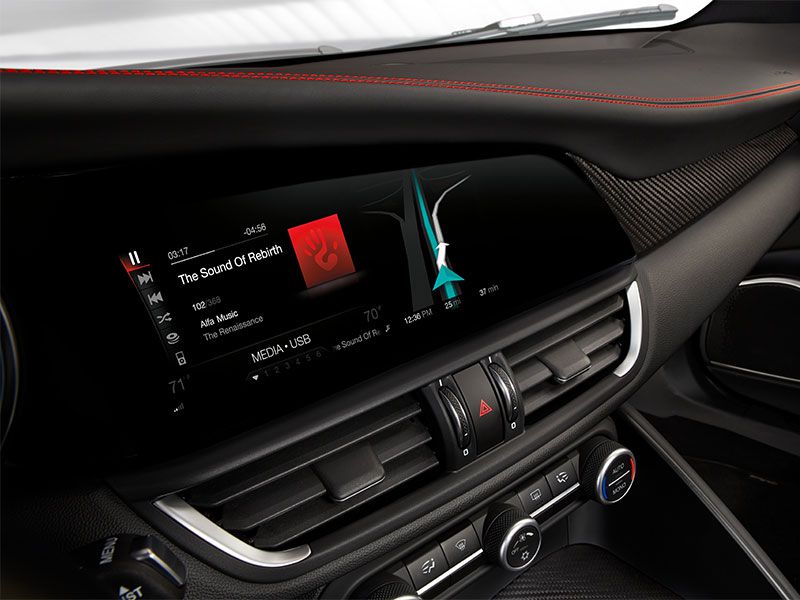
Photo by Fiat Chrysler Automobiles
A different kind of driving experience.
Beautiful as it is, driving the Giulia is best. Immediately upon hitting the road, you’ll notice that the Giulia’s steering features an unusually quick ratio, meaning it takes less movement of the steering wheel to elicit a reaction from the car. Changing lanes literally can be done at the flick of the wrist, and in fact one must remember to avoid big movements to keep the car from acting like it were a pinball. When Alfa’s engineers first told us about the quick-ratio steering, I had to suppress a groan: Such setups usually make the car a bear to drive on straight freeways, as the car constantly darts from one side to the other. Shame on me for having so little faith: The Giulia tracks straight and true, and there’s just enough of an on-center “dead” spot to eliminate the nervous twitching I expected. But when you do want to change direction, the Giulia is quick to respond, and on a curvy road one almost seems to steer the car with one’s thoughts rather than one’s arms. It’s a wonderful setup that instantly distinguishes the Giulia from its rivals.
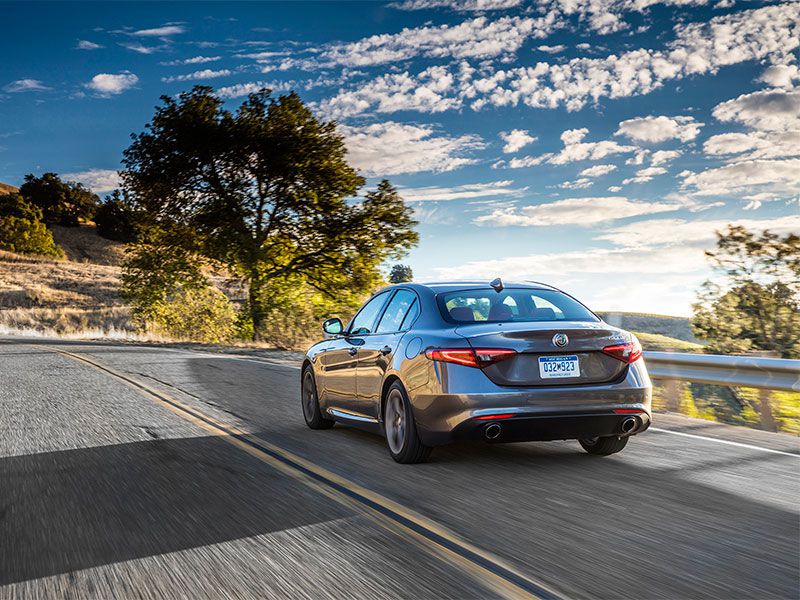
Photo by Fiat Chrysler Automobiles
Impressive Base Engine
Alfa is offering the Giulia with two engines. Most buyers will opt for the base and Ti models, which are powered by a 2.0-liter turbocharged 4-cylinder engine. The bulk of the Giulia’s competitors offer similar setups, and all are quite good; even so, we will freely admit to being very impressed by the Alfa’s output of 280 horsepower and 306 lb.-ft. of torque, and with the flat, linear power curve (a product of Fiat’s MultiAir variable valve-timing system). Available with an 8-speed automatic and rear- or all-wheel drive, the 4-cylinder Giulia is very quick—0-60 mph in 5.1 seconds, according to Alfa—though we were a bit disappointed by the exhaust note. We were hoping for something exotic and Italian, but the 2.0-liter engine sounds more like a Toyota.
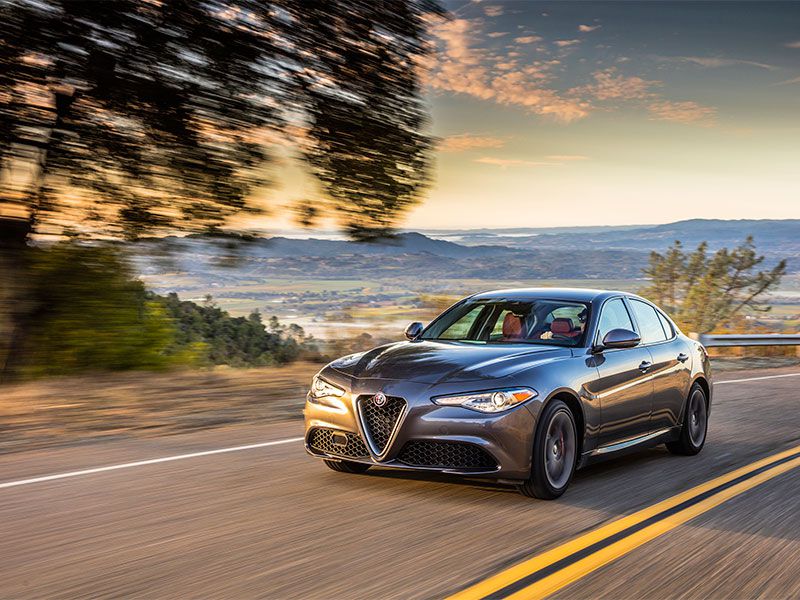
Photo by Fiat Chrysler Automobiles
...and then there’s the Quadrifoglio.
Better noises come courtesy of the Giulia Quadrifoglio, which gets a 2.9-liter twin-turbo V6 putting out—are you ready for this?—five hundred and five horsepower and 443 lb.-ft. of torque. Right away, that gives the Giulia bragging rights over the BMW M3 (425 hp/406 lb.-ft.), Audi S4 (354/369), and—on horsepower, though not torque—the Cadillac ATS-V (464/445) and Mercedes C63 S (503/516). It’s no surprise to learn that the engine was developed in conjunction with Ferrari, another Fiat subsidiary, and it delivers the speed and sound one would expect from an Italian exotic. Alfa estimates the 0-60 mph run in 3.8 seconds, enough to chase down local toffs in Lamborghinis. With a name like Quadrifoglio—Alfa staffers abbreviate it to QV, though I have no idea what the V stands for—you’d expect all-wheel drive, but in fact this is a rear-wheel-drive machine—Quadrifoglio means 4-leaf clover, the logo of Alfa’s performance cars.

Photo by Fiat Chrysler Automobiles
A wet day on the track.
Alfa gave us a chance to run the Giulia Quadrifoglio on Northern California’s Sonoma raceway; unfortunately, it was a rainy day and the combination of 443 lb.-ft. of torque, rear-wheel-drive, and Sonoma’s notoriously slick pavement did not make for a day of record-setting lap times. Sliding around Sonoma did give us a feel for the Giula’s good natural chassis balance. The car was eager to oversteer (fishtail) on the wet pavement, but we were able to correct with minimal drama asnd limited intervention from the Giulia’s stability control system. The Quadrifoglio has a “race” mode that relaxes the electronic nannies, but we had no interest in trying it out on a rainy day. The extra horsepower is good fun out on a curvy road, and the ride is only a wee bit stiffer than the 2.0-liter cars's. The 8-speed automatic works well, though it seems a shame that this driver’s car won’t be offered with a manual transmission in the States as it is in Europe.
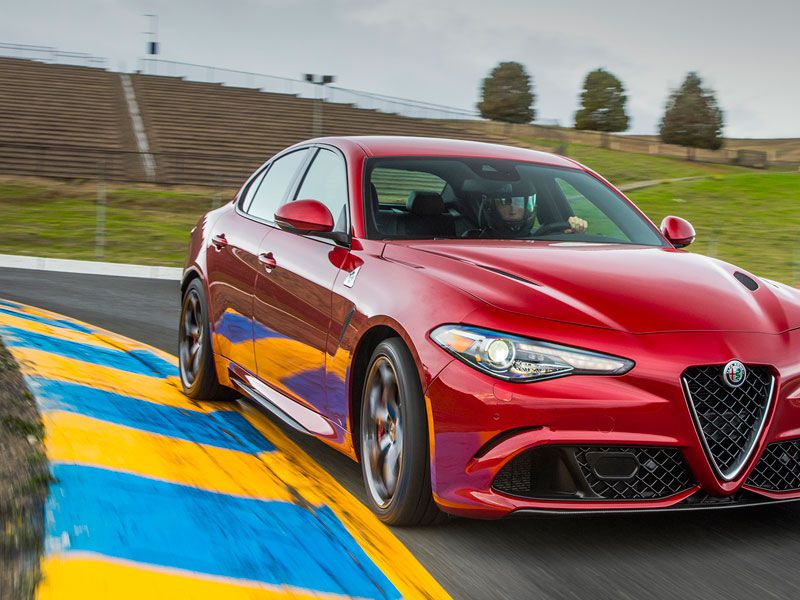
Photo by Fiat Chrysler Automobiles
A Triumphant Return for Alfa Romeo
We came away from our first drive of the 2017 Alfa Romeo Giulia with big grins—and not just from the 505-horsepower Quadifoglio model. The Giulia is a welcome addition to the luxury car segment, a car that brings Italian flare and a genuine passion for driving to a field dominated by technology-obsessed German cars, tightly wrapped Japanese cars, and somewhat unfocused American cars. Alfa Romeo didn't tell us thr price, but it is estimated that the Giulia will start in the low-$40,000 range while the Quadrifoglio will top out around $70,000. Build quality is a concern; our test cars seemed solidly screwed together, but reliability was not a strong point for Alfa Romeo in the old days, and neither Fiat nor Chrysler are known for Toyota-like levels of quality. Still, we have high hopes for the Giulia: It is a breath of fresh air, something truly different in a world of cars that are increasingly alike. Whatever Alfa Romeo meant to you before, we think it will mean great things now and in the future.
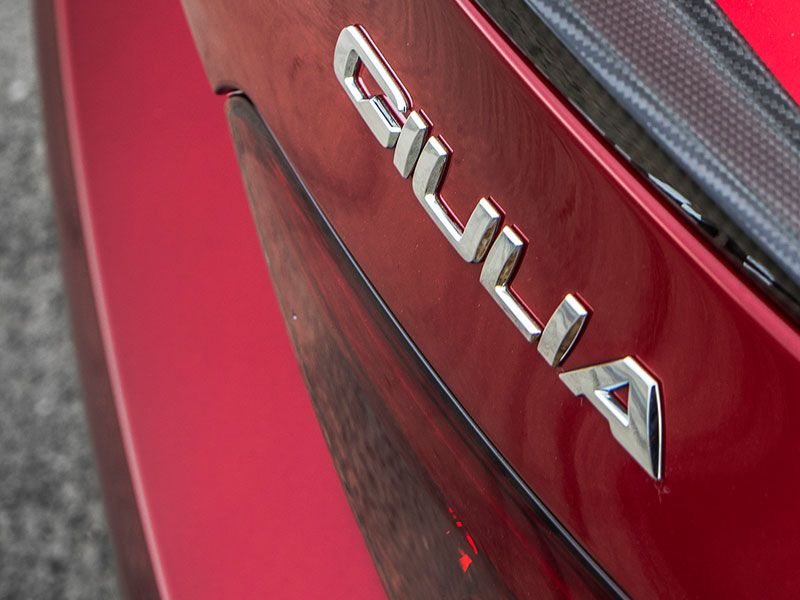
Photo by Fiat Chrysler Automobiles